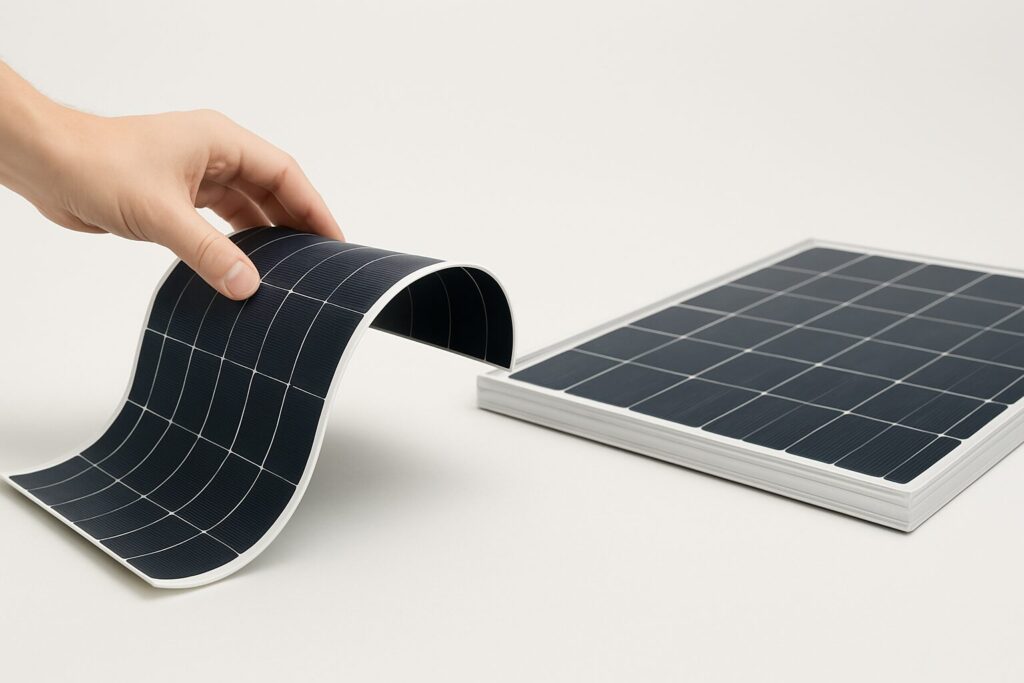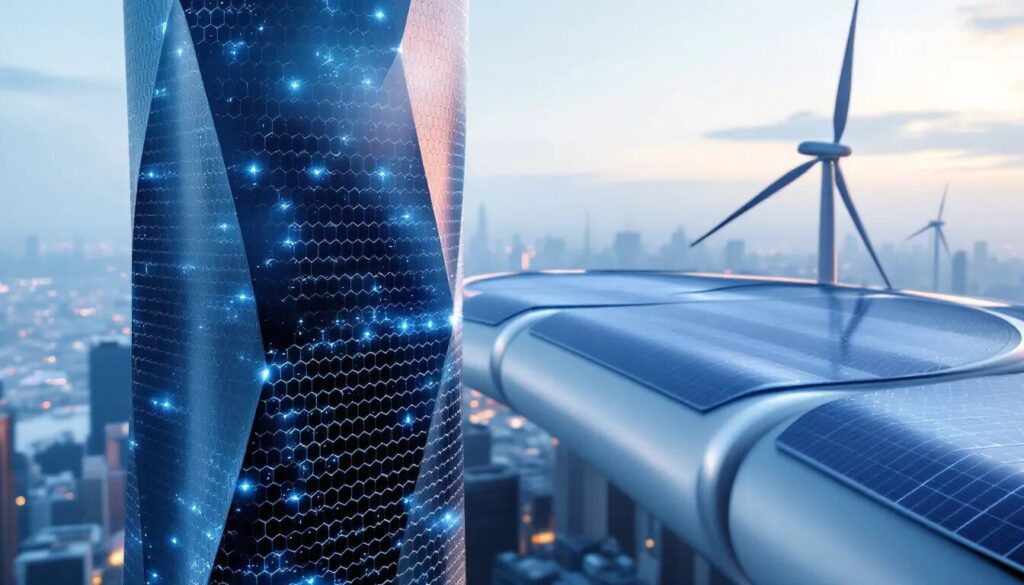Phone:
(701)814-6992
Physical address:
6296 Donnelly Plaza
Ratkeville, Bahamas.

Curious about flexible solar panel efficiency? This article breaks down how flexible panels convert sunlight into energy, how they compare to rigid panels, and what impacts their performance.

Solar panel efficiency is a crucial indicator of their ability to transform sunlight into utilizable energy, an important measure that affects their applicability in different settings. When it comes to flexible solar panels, the quest for heightened efficiency requires overcoming distinctive obstacles while capitalizing on the particular benefits intrinsic to their construction.
Gaining knowledge about these factors can offer a more profound understanding of the elements that propel the efficiency of flexible solar panels forward.
Flexible solar panels are composed of slender photovoltaic material strata, mainly monocrystalline silicon, which is crucial for their energy conversion efficiency. Due to the reduced amount of conductive material from the thinner layers, there’s an inherent decrease in these panels’ overall efficiency. Although this thinness enhances panel flexibility, it concurrently restricts their ability to conduct electricity effectively, possibly leading to a drop in performance. The manufacturing process is also key since achieving the average 15-18% efficiency level that these panels provide requires precision-controlled conditions.
The longevity and sustained performance of flexible solar modules also hinge on their durability. They’re engineered to endure rigorous weather scenarios, including those found in maritime environments. This endurance helps preserve operating efficiency over time. Their lightweight attribute offers added benefits for marine applications by cutting down on structural load—thereby improving both stability and energy efficiency.
In regions experiencing intense heat and abundant sunlight exposure like deserts, flexible solar technology demonstrates remarkable proficiency due to its adaptability under such extreme conditions. These resilient features allow them to perform consistently across various climatic zones—making them a versatile option within the realm of solar power generation solutions.
Efficiency serves as a critical distinction when contrasting flexible solar panels with their rigid counterparts. Rigid solar panels achieve efficiency rates of around 20% to 25%, making them superior for generating energy on a large scale. Meanwhile, although typically less efficient—often falling below the 20% mark—the unique characteristics of flexible solar panels render them apt for certain contexts where traditional rigid panels would be unsuitable.
Despite the restricted efficiency levels impacting their suitability for fixed installations needing greater energy output, flexible solar panels are exceptionally well-suited to portable and specialized applications thanks to their lightness and adaptability. Their resilience under high wind conditions or severe weather makes these flexible units notably beneficial in such environments.
In situations where standard conventional panels prove inadequate, it’s here that flexible solar options truly excel. Given their capacity to mold onto curved surfaces and endure strenuous circumstances, they’re ideal choices for use on structures like recreational vehicles (RVs), boats, or architectural elements not engineered to bear the heavier load associated with typical rigid systems. Despite lower efficiency figures, this design versatility often outweighs those limitations in numerous practical scenarios.

The domain of flexible solar technology is experiencing swift advancements, fueled by a constant stream of innovations and enhancements. Such progress is anticipated to profoundly influence both the demand for, and market behavior surrounding, flexible solar panels.
Due to their capacity to be mounted on virtually any location—even those with irregular topographies—flexible solar panels provide unmatched adaptability. The strides being made in this area are not only boosting the efficiency of these panels, but also facilitating greater affordability and accessibility.
At the core of advancements in flexible solar panel technology are pioneering materials. The performance of these panels is being elevated through the use of organic solar cells and graphene electrodes, with a particular emphasis on refining organic cells to improve their light absorption and energy conversion efficiency. Graphene stands out for its remarkable flexibility and strength, which contributes to making flexible solar panels more durable and less susceptible to damage.
Researchers are directing efforts towards developing ultralight fabric-based solar cells that can be woven into clothing or attached to portable devices. This expansion broadens the scope of where flexible solar technology can be utilized, envisaging a future where harnessing solar energy becomes an integral part of our daily routines.
Innovations such as bifacial solar panel designs capture sunlight from both sides, significantly boosting power generation capabilities. This advancement exemplifies the forward-thinking trajectory within the realm of flexible solar technologies aimed at optimizing both efficiency and versatility across diverse applications for flexible photovoltaic systems.
Improvements in the production methods are vital for enhancing both the efficiency and dependability of flexible solar panels. Such advancements are contributing to a reduction in manufacturing expenses, thereby making flexible solar more economically feasible and broadly available. Refined production processes are allowing for the creation of panels with greater uniformity and consistent performance, critical factors for attaining improved efficiency.
Continual progress in manufacturing techniques is anticipated to Diminish production expenses while boosting both the efficacy and quality oversight of flexible solar panels. With these evolving technologies, the outlook is optimistic regarding flexible solar options becoming increasingly practical for an expanded spectrum of uses.

In real-world scenarios, to maximize the performance of flexible solar panels, it’s essential to focus on their strategic installation and consistent upkeep. These panels are notably efficient for spacious homes or business premises with sufficient roof areas, as well as for mobile applications such as RVs and boats.
Choosing optimal methods for both installing and maintaining these flexible solar units can greatly influence not only their operational efficiency but also extend their useful life.
It’s essential to install flexible solar panels properly to ensure they operate at peak efficiency. These types of panels are ideally mounted on surfaces that can conform to their flexible nature, such as the uniquely shaped roofs found on RVs and boats. Their design is particularly beneficial for vehicles with intricate roof designs due to their ability of bending to fit these contours. The simplicity in mounting them without bulky hardware makes for a fast and versatile setup, which proves advantageous when used in mobile settings.
In terms of marine use, not having metal brackets means there’s less risk of rusting, thereby increasing the lifespan and durability of the flexible solar panel installation. Employing a vented gap kit during set-up can enhance both thermal expansion management and air circulation around the panels, leading to improved operational efficiency. Ensuring that surfaces are thoroughly cleaned and free from grease is key for securing robust adhesion upon installing these panels. This step is critical for maintaining both longevity and optimal functionality over time. Utilizing solar panel kits can also make this process more efficient.
To maintain high performance levels over an extended period, it’s imperative consistently check both mechanical attachments as well as electrical connections related to your flexible solar energy system. Keeping your solar modules clean using just soap and water significantly aids inefficiency by removing any accumulation of dirt or debris that may obstruct sunlight from reaching the cells within each module.
It is essential to conduct periodic checks for any signs of damage, such as rips or fissures, in order to preserve the performance of flexible solar panels. These panels boast an IP68 rating and are waterproof, allowing them to withstand being submerged underwater and making them resilient across diverse climatic conditions. Regular cleaning is crucial to prevent the accumulation of grime and debris on their surface, which can impede sunlight exposure and diminish efficiency.
Cleaning intervals for flexible solar panels typically range from every three months to semi-annually. If they encounter substantial amounts of dirt or dust in certain environments, more frequent cleaning may be necessary. By following these maintenance recommendations faithfully, one ensures that flexible solar panels continue functioning at optimal levels providing consistent and eco-friendly energy solutions.

The practical use of flexible solar panels shows their effectiveness and adaptability. These lightweight, portable energy solutions are ideal for mobile settings like RVs and boats that require flexibility.
Looking at individual examples illustrates the way in which flexible solar panels improve self-reliant living and eco-friendliness for those who live off the grid.

The existing infrastructure is built to accommodate a range of applications, yet it often faces challenges when trying to integrate seamlessly with current systems.
Flexible solar panels provide considerable benefits for installations in RVs and campers. Their light construction increases convenience and lessens the load on recreational vehicles. Flexible solar panels conform well to the contours of an RV roof, allowing them to capture more energy and make efficient use of space. Due to their valued portability and high efficiency, flexible solar panels are widely used not only in RVs, but also in boating, camping, and hiking scenarios.
To summarize:
Solar cells constructed from ultralight materials significantly outperform traditional solid counterparts regarding power-to-weight ratio. This makes them particularly suited for mobile settings where bulkiness can be problematic. This advanced attribute allows owners of such vehicles as RVs continual access to electricity without being burdened by heavy gear.
Flexible solar panels provide a highly efficient energy solution for marine use, as they can be mounted effortlessly onto the curved surfaces of boats due to their adaptable design. The lightweight nature of these panels facilitates simple installation on a variety of surfaces, rendering them perfectly suited for the varying designs encountered in marine settings.
The durability and ability to withstand severe maritime conditions make flexible solar panels particularly suitable for boat applications. These waterproof and weather-resistant units guarantee consistent performance even in challenging environments, delivering a reliable source of sustainable energy tailored for nautical purposes.

Advancements in solar technology, particularly within the realm of flexible solar panels, are anticipated to greatly enhance their efficiency. These improvements stem from cutting-edge designs and novel production methods that have recently emerged.
The use of materials such as perovskite in forthcoming panel models is poised to elevate energy conversion efficiency while simultaneously reducing manufacturing expenses. Such progress indicates a prosperous outlook for the realm of flexible solar energy, underscoring its potential as an effective and increasingly practical source of power.
New technologies, such as perovskite solar cells, are noted for their promising low production costs and superior efficiency levels, which make them an excellent candidate for use in flexible solar panel applications. Continuous research into perovskite materials is expected to result in substantial enhancements to the efficiency of these types of panels.
As progress with these technologies unfolds, it’s anticipated that there will be significant improvements to the efficacy and availability of flexible solar panels. This advancement should contribute to a wider acceptance and utilization across diverse uses, reinforcing the importance of flexible solar solutions within the realm of renewable energy sources.
Please reach out to us for Details on LINKSOLAR’s products featuring flexible solar panels. Our dedicated team is on standby to answer your inquiries and provide comprehensive data regarding our assortment of flexible solar panel offerings, as well as customization options we provide.
The distinctive benefits of flexible solar panels lie in their malleable, lightweight construction and the ability to conform to a wide range of surfaces. Although these panels typically have lower efficiency rates than their rigid counterparts, ongoing improvements in materials engineering and production techniques are steadily enhancing their performance capabilities. To get the most out of flexible solar technology, users should focus on understanding what influences efficiency, adopt best practices for panel installation, and maintain regular upkeep.
Looking ahead, prospects for advancements in flexible solar panel technology appear promising with new developments poised to boost both efficacy and cost-effectiveness. Flexible solar panels serve as an indispensable tool within our renewable energy arsenal, especially suited for mobile environments such as RVs and boats or non-traditional architectural structures. By adopting flexible solar solutions, we can support the momentum towards a more sustainable future.
The performance of flexible solar panels is significantly affected by the types of materials selected, the production techniques utilized, and the environmental conditions they are subjected to during operation.
Improving these elements can lead to better overall efficiency for flexible solar panels.
Flexible solar panels generally have lower efficiency rates, typically achieving 15-18%, compared to rigid solar panels, which can reach 20-25% efficiency.
Therefore, if efficiency is your primary concern, rigid solar panels are the better option.
To ensure the best installation of flexible solar panels, it is important to mount them on surfaces that can support their flexible curves. Using a clean and degreased surface as well as incorporating a vented gap kit will improve their efficiency.
Adhering to these methods will greatly enhance the performance of the solar panels.
Flexible solar panels require regular inspections for damage and should be cleaned every 3 to 6 months, or more often if they accumulate significant dirt or dust, to maintain optimal performance.
Advancements in technologies like perovskite solar cells are poised to enhance the efficiency and cost-efficiency of flexible solar panels, indicating a bright future for their development.
Such progress is expected to facilitate broader acceptance and amplify the potential for energy generation using these flexible panels.